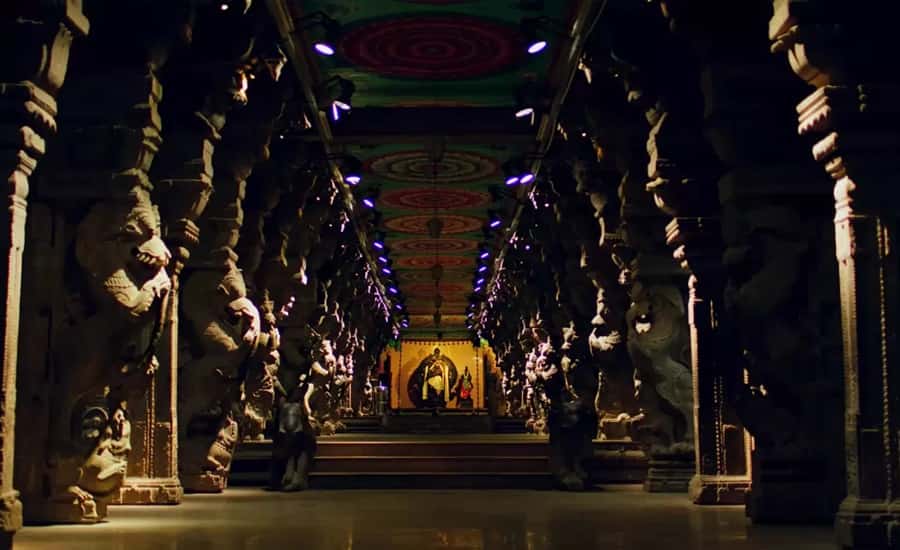The Meenakshi Temple, situated in the heart of Madurai, Tamil Nadu, is not just a place of worship but a testament to the rich cultural heritage and architectural brilliance of India. This sacred site attracts millions of devotees and tourists from around the world, drawn by its captivating history, deep-rooted mythology, and intriguing legends.

Early Origins and Construction (12th – 13th Century CE)
The history of Meenakshi Temple traces back to the 12th and 13th centuries CE when it was initially constructed. King Kulasekara Pandya, a poet-saint king, is credited with the earliest surviving portions of the temple complex. He erected structures such as the three-storeyed gopura at the entrance of Sundareswarar Shrine and the central portion of the Goddess Meenakshi Shrine. Legend has it that the king was inspired by a divine dream where he was instructed to build a temple at the spot where he found a lingam engulfed by the earth. Thus, the Meenakshi Temple was born, dedicated to the divine couple, Lord Shiva and Goddess Meenakshi.
Mythological Significance of Meenakshi and Sundareswarar
The temple’s mythology revolves around the divine couple, Meenakshi and Sundareswarar, whose union symbolizes the cosmic balance of masculine and feminine energies. According to the legend, Meenakshi, an incarnation of the goddess Parvati, was born with three breasts, a sign that she would marry a man who possessed exceptional qualities. When she met Lord Shiva, her third breast disappeared, signifying the fulfillment of her destiny. The couple ruled over the kingdom of Madurai, showcasing their divine love and power. The Meenakshi-Sundareswarar wedding ceremony, celebrated annually during the Chithirai Festival, attracts thousands of devotees who come to witness the divine nuptials and seek the blessings of the celestial couple.
Expansion and Renovation (13th – 16th Century CE)
Over the centuries, the Meenakshi Temple underwent numerous expansions, renovations, and additions under different rulers and patrons. Maravarman Sundara Pandyan I and II, along with other rulers, contributed to the temple’s growth. Various gopuras (tower gateways), mandapams (pillared halls), and shrines were added to the complex, enriching its architectural and artistic grandeur. The Vijayanagara rulers played a significant role in revitalizing the temple after periods of decline, leading to the construction of magnificent gopuras and structures like the Nayaka gopuram and Palahai gopuram. These additions transformed the temple into a sprawling complex, reflecting the diverse religious and cultural influences of the time.
Legends and Miracles Associated with Meenakshi Temple
The Meenakshi Temple is steeped in legends and miracles that have captivated devotees for centuries. One such legend tells the story of the “golden lotus tank,” a sacred pond within the temple complex. According to myth, Lord Shiva emerged from the tank in the form of a lingam, symbolizing his divine presence and blessings. Another popular legend revolves around the “hall of a thousand pillars,” an architectural marvel within the temple. It is said that each pillar emits a different musical note when struck, creating a celestial symphony that resonates throughout the hall. These legends, along with many others, continue to inspire awe and reverence among devotees who flock to the Meenakshi Temple to experience its divine ambiance and spiritual vibrations.
Modern Era and Cultural Significance
In the modern era, the Meenakshi Temple remains a focal point of Hindu worship and cultural heritage in Tamil Nadu. Preservation efforts have been ongoing to protect the temple’s architectural splendor and cultural legacy. Renovations and restorations have been carried out to maintain the temple’s structural integrity and ensure its accessibility to devotees and tourists. The temple’s annual festivals, including the Meenakshi Thirukalyanam and Chithirai Festival, continue to draw crowds from far and wide, showcasing the rich cultural traditions and religious fervor associated with the temple. Today, the Meenakshi Temple stands as a living testament to centuries of devotion, mythology, and architectural brilliance, inspiring awe and wonder in all who visit its sacred precincts.

 Call
Call WhatsApp
WhatsApp Enquiry
Enquiry